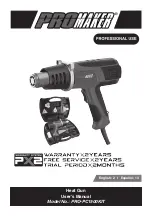
E-POW
INSTRUCTION MANUAL Release 1 date 05-09-2013
5
QP+, QP-
Start permit.
Connect respectively to the positive and negative poles of the operation circuit, down line of
the safety chain contacts.
IM
Command for operation in inspection mode.
Connect in such a way that, when the inspection service is enabled by means of the specific
control station on the car roof, a contact closes between CF and IM. This is to assure the
proper working sequence and the car run in medium speed (< 0,63 m/sec).
CAUTION!
In the event of uncertainty, please consult SMS for advice about the correct connection of the
adaptation board.
3.4 BRAKE CONTROL
E-POW features internal contactor TF to control the BRAKE: the TAKEDO 3VF NXP drive manages the
brake control logic directly so that the relative contactor opens only in conditions of safety (motor supplied
with power, with current balanced on all three phases) and closes when the motor stops as the car reaches a
floor.
Contactor TF is wired by SMS; the two conductors TFL2 – TFL3 must be connected in series with the brake
coil power supply.
Fig. 2:
Connection of the brake control contactor
3.5 FURTHER NOTES ABOUT THE APPLICATION
1. E-POW operates in closed loop, so, to assure the encoder right operation, it is essential that the run
direction is managed by the drive, which has to control and reverse the motor phases.
In the existing control panel you need to modify the power circuit, in order that the up / down contactors
don’t reverse the motor phases.
2. E-POW controls the High Speed winding of the motor: disconnect the Low Speed winding.
3. Make sure that the door opening command for the automatic doors (if any) is enabled after the contactor
de-energization (controlled by E-POW).
4. Make sure that the Retiring Cam (if any) unlocks the door after the contactor de-energization.
4 – OPERATION
When it receives an up or down run command from the control panel, E-POW activates the contactors and,
via the inverter drive, causes the car to move.
If the SW1 switch is set to RUN and the CF1 command is OFF, the movement is performed at high speed;
when the CF1 command from the control panel turns ON, the low speed level is set and the car decelerates.
When the car reaches the floor level, CF1 and QU/QD are disabled: the drive stops the motor electrically and
afterwards E-POW controls the brake deactivation and then contactors deactivation.
There isn’t any MAXIMUM RUN TIME, neither in high speed nor in low speed, in order to avoid ill-timed
action of these protections in case of last long runs or long distances covered in low speed, for instance
during set-up (these controls are usually already included into the most recent control panels).
If the SW1 switch is set to MAN, the car moves in the selected direction at the inspection speed, as long as
the control panel command or the up/down command from the board push-buttons remains active: when the
command breaks off, the car stop instantly, with the brake release.
During all operations, E-POW controls the brake contactor TF. When the drive detects an alarm situation, the
brake is released instantly.
BRAKE POWER
SUPPLY
BRAKE
TFL2
TFL3

























